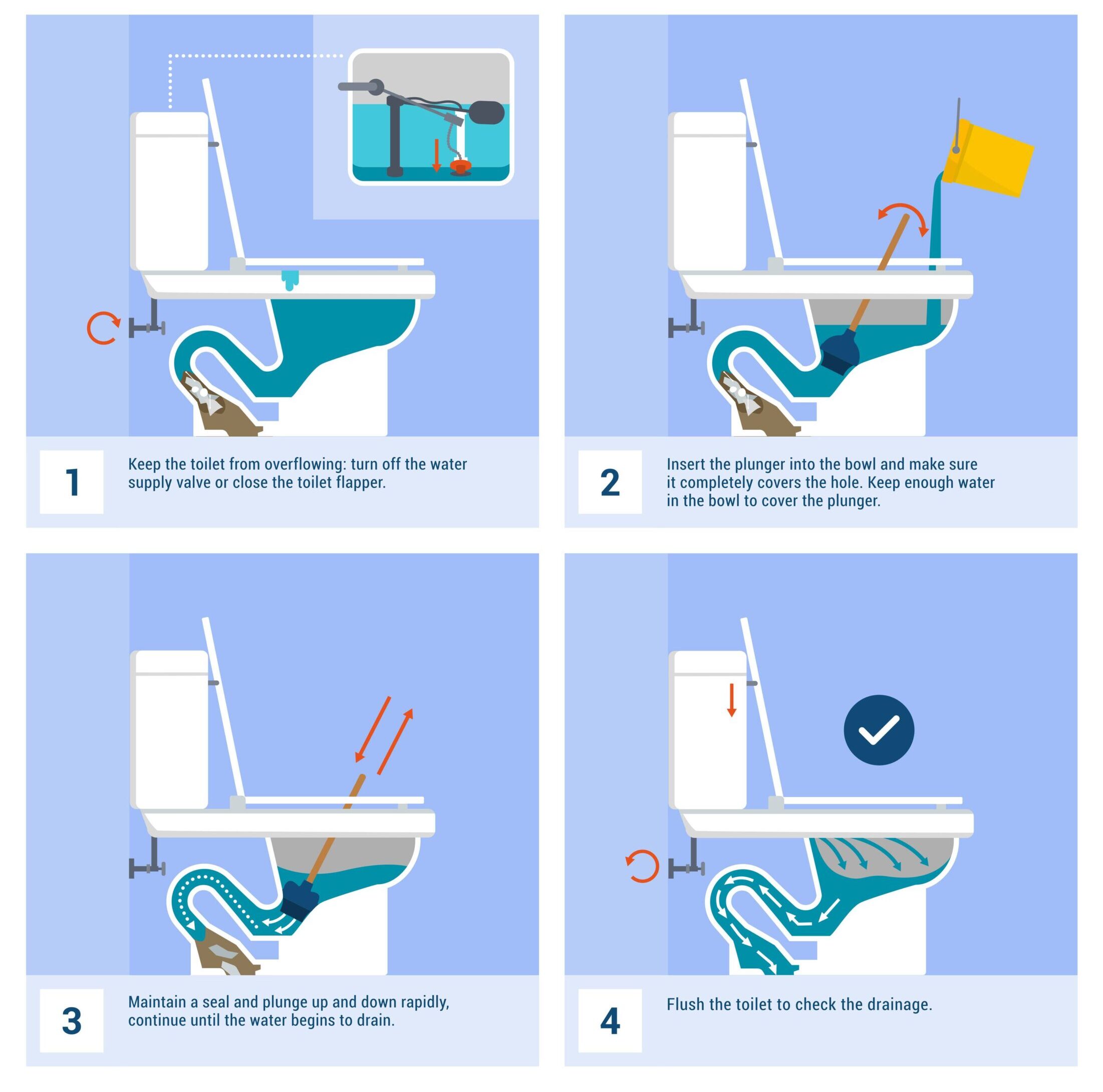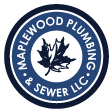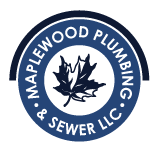We’ve all been there. You flush, and instead of everything going down, the water starts rising. And rising. Suddenly you’re panicking, trying to figure out what to do before your bathroom floods. Take a breath. This is fixable. Our covers everything you need to know about how to unclog your toilet.
What to Do Right Now
If the water is rising toward the rim, here’s the first things you need to do:
- Take the lid off the tank and push the flapper down (that’s the rubber thing at the bottom) to stop more water from entering the bowl. If water is still rising, turn off the water valve behind the toilet by turning it clockwise.
- Don’t flush again. I know it’s tempting to try “just one more flush” but trust me, it won’t help and you’ll just add more water to deal with.
- Wait a few minutes. Sometimes a clog will partially clear itself as the water slowly drains. If the water level drops significantly after 10 minutes, you might get lucky with a simple plunge.
How to Unclog Your Toilet, Step-By-Step

Step 1
Make sure there’s enough water in the bowl to cover the plunger head. If not, add some from a bucket. You need water to create the pressure that clears the clog.
Step 2
Lower the plunger into the water at an angle to fill the bell with water (this prevents air pockets). Position it over the drain hole and make sure you have a good seal all around. Start with a gentle first plunge to expel any air from the plunger. This helps you prevent any nasty splashing.
Step 3
Now plunge vigorously up and down, maintaining the seal. You want to create a push-pull effect in the drain. Think of it like CPR for your toilet — firm, rhythmic compressions. Do this 15-20 times.
Step 4
Break the seal with a quick pull and see if the water drains. If it drains but slowly, repeat the process. If it drains normally, do a test flush (but be ready to stop it if needed).
What If I Don’t Have a Plunger?
Wondering how to unclog a toilet without a plunger? Whether a plunger isn’t available or the above steps just aren’t doing the trick, these two simple methods can clear most clogs surprisingly well.
Option #1
- Step 1: Squirt a generous amount of dish soap into the toilet bowl. Like, really generous – about 1/4 cup. Shampoo works too if you’re out of dish soap. The soap helps lubricate and break down the clog.
- Step 2: Let it sit for 5-10 minutes. While you’re waiting, heat up about a gallon of water. You want it hot but not boiling (boiling water can crack porcelain). Think hot bath temperature.
- Step 3: Pour the hot water into the bowl from waist height. The force and heat help break up the clog. Be careful not to overflow the bowl.
- Step 4: Let it sit for 10-20 minutes. The combination of soap, hot water, and time works to break down most organic material.
- Step 5: Try flushing. If it’s still clogged but the water level has gone down, repeat the process.
Note: This method is especially good for toilet paper clogs and, well, natural waste. It won’t help with toys or other objects though.
Option #2
If you’ve tried plunging and the hot water method with no luck, it’s time for the toilet auger (also called a toilet snake).
- Step 1: Insert the auger’s curved tip into the toilet drain. The rubber sleeve protects your toilet’s porcelain from scratches.
- Step 2: Crank the handle clockwise while applying gentle downward pressure. You’ll feel resistance when you hit the clog.
- Step 3: Keep cranking to work through the clog. You might feel it suddenly give way. If you feel like you’re hitting a wall and can’t go further, you’ve likely reached the main drain pipe.
- Step 4: Once you’ve worked through the clog (or gone as far as you can), slowly pull the auger back out while continuing to crank. This helps grab any debris.
- Step 5: Flush to test. You might need to plunge once or twice to clear any loosened debris.
What’s Actually Causing the Clog?
- Too much toilet paper is the most common culprit. Even if it’s supposed to be flushable, using half a roll at once will clog any toilet. This responds well to plunging and hot water.
- “Flushable” wipes are the devil. They don’t break down like toilet paper and are responsible for countless clogs. If you flushed wipes, you’ll probably need aggressive plunging or an auger.
- Foreign objects like toys, dental floss, cotton swabs, or feminine products create stubborn clogs. These usually require an auger or professional help.
- Hard water mineral buildup narrows your pipes over time. If your toilet regularly clogs with normal use, this might be your issue. You’ll need professional cleaning.
- Main sewer line problems affect multiple drains. If other drains are backing up too, stop and call a plumber. This is beyond DIY territory.
Tips About How to Avoid Future Clogs
The biggest culprit in most clogs is simply using too much toilet paper at once. If you need a lot, flush halfway through. It’s better to flush twice than deal with a clog when you’re running late for work or have a house full of guests.
Even those “flushable” products shouldn’t go down your toilet. Wipes are the worst offenders (yes, even the ones that say flushable), but the list of problem items includes cotton balls, q-tips, dental floss, cigarette butts, and feminine products.
Regular maintenance makes a huge difference too. Clean your toilet regularly, especially under the rim where jets can get clogged with mineral deposits. When those jets get blocked, your flush loses power, and weak flushes lead to clogs. It’s a downward spiral that’s easily prevented with a toilet brush and some cleaner once a week.
If your toilet was made before 1994, it might be time for an upgrade. I know nobody gets excited about buying a new toilet, but modern toilets use less water while flushing more effectively. The technology has genuinely improved, and newer models prevent clogs better than those old water-wasters.
And if you notice your toilet draining slowly or not flushing with its usual power, that’s your toilet telling you a clog is coming. Deal with it now with some preventive plunging or hot water treatment before it becomes a complete blockage at the worst possible moment.
Lastly, if you have kids, take five minutes to have the “toilet talk.” Explain that toilets aren’t magic portals where toys go on adventures. Half of all toilet clogs involving toys could be prevented with a simple conversation about what can and can’t be flushed.
Common Mistakes That Make Things Worse
After years of fixing toilets, here are the mistakes I see people make constantly:
- Flushing repeatedly hoping the clog will clear just adds more water to your problem. One flush to test is enough. If it doesn’t work, stop flushing.
- Being too gentle with the plunger won’t create enough pressure. You need forceful plunges to clear most clogs.
- Ignoring the warning signs like slow draining or weak flushes means you’ll deal with a complete clog soon.
Special Situations & Other Quick Fixes
Apartment or Condo Dwellers
If you’re in an apartment, your clog might affect neighbors, or theirs might affect you. Try basic plunging first, but contact maintenance quickly if it doesn’t work.
Septic System Homes
If you have a septic system, be extra cautious about what goes down your toilet. Avoid toxic chemical cleaners entirely, as they can kill the beneficial bacteria in your septic tank.
Old House Problems
Older homes often have cast iron pipes that accumulate buildup over decades. If you’re constantly dealing with clogs in an older home, you might need professional pipe cleaning.
The Bottom Line on Toilet Clogs
Most toilet clogs are easily fixed. The key is using the right plunger, creating a good seal, and using forceful plunges to create pressure in the pipe. If that doesn’t work, try those other methods we mentioned. And if things get beyond your comfort level? There’s no shame in calling a professional.
Wipe Away Your Worries… It’s Just a Clog
Sometimes you’ve tried everything and that toilet still won’t cooperate. Or maybe you’d rather not deal with it at all (we don’t judge). That’s where Maplewood Plumbing can help. We’ll get your bathroom back to normal fast.
Comments are closed


